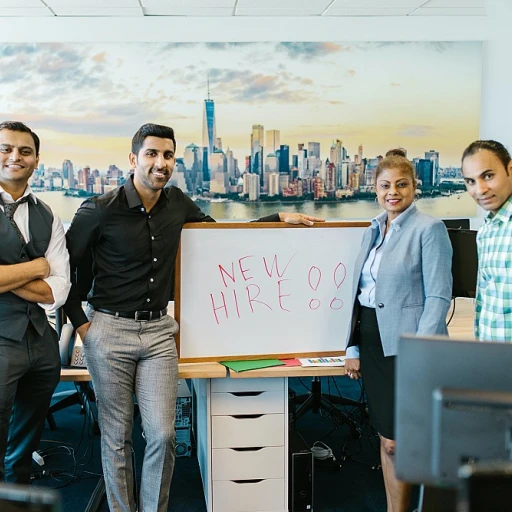What Makes a Leader Strategic?
Traits that Differentiate Strategic Leaders
In today's ever-evolving business landscape, the ability to lead with intention and foresight is crucial for leaders who aim to spearhead successful organizations. But what exactly sets apart those leaders who truly excel in crafting and executing strategy? At the core, strategic leaders possess a unique set of traits and skills that enable them to navigate complexity and drive their teams towards a shared vision.
Firstly, strategic leaders have an exceptional ability to think ahead. They are not only focused on current challenges but also on future opportunities and threats. This foresight allows them to develop a roadmap that aligns with their long-term goals. Their capacity for critical thinking and problem-solving empowers them to make decisions that consider both the short-term impacts and long-lasting consequences.
Agility and adaptability are additional hallmarks of strategic leaders. They thrive in environments of change and uncertainty, adjusting their strategies as needed to respond to emerging trends or unexpected shifts in the market. This flexibility doesn't mean they lack commitment; rather, they are committed to the success of their organization and are willing to pivot when necessary.
Emotional intelligence also plays a pivotal role in strategic leadership. Leaders who understand and manage their own emotions, as well as empathize with those of their team members, can foster a collaborative and trusting work environment. This emotional savvy is critical when it comes to engaging all levels of an organization in the pursuit of shared objectives.
Moreover, strategic leaders are adept communicators. They can articulate their vision clearly and persuasively, ensuring that every team member understands their role in the bigger picture. This skill is examined further as we delve into the role of communication in effective leadership.
To gain a deeper understanding of the competencies required for this type of leadership, it's important to explore the nuances of
strategic thinking in leadership development. These insights are foundational for those aspiring to become impactful strategic leaders.
Building Leadership Skills for Long-Term Success
Key Components of Strategic Leadership Development
In the ever-evolving landscape of strategic leadership, developing skills that ensure long-term success is paramount. It's not just about having the right ideas but also possessing the ability to implement these ideas effectively. For leaders aspiring to excel, understanding the fundamental components that contribute to long-term success is essential.
One crucial aspect lies in the leader's ability to foresee challenges and opportunities before they fully emerge. This foresight enables leaders to guide their organizations through turbulent times, positioning them for sustained growth and success. The ability to adapt and thrive under changing circumstances is especially vital in today’s dynamic environment.
Another indispensable component is the cultivation of decision-making skills. Strategic leaders need to make informed decisions promptly, even in the face of uncertainty. This requires a deep understanding of both their organization and the external environment, allowing them to weigh the pros and cons of each potential action effectively. Developing such a skill set requires continuous learning and reflection, as decisions made today can have long-lasting implications.
Leadership is not an isolated endeavor. Successful leaders recognize the importance of collaboration and the value of diversity within their teams. By fostering an inclusive environment where various perspectives are welcomed and encouraged, leaders can leverage the strengths of their team members to drive innovation and achieve holistic solutions.
To explore more on how to refine your leadership dynamics for success,
this comprehensive resource provides insightful strategies and tools.
Combined, these components create a robust framework for developing leadership skills that enable a leader to guide their organization towards long-term success. As you equip yourself with these capabilities, you'll be better prepared to face the inevitable challenges of leading with strategic insight and competence.
Remember, shaping your leadership abilities is an ongoing journey. As you continue to refine your skills, always be on the lookout for opportunities to learn from both your experiences and those of renowned strategic leaders. This commitment to improvement is what will ultimately set you apart as a truly effective and strategic leader.
In the subsequent sections, we will delve into how effective communication plays a pivotal role in strategic leadership, as well as showcasing inspiring examples of successful leaders who've made their mark through strategic prowess.
The Role of Communication in Effective Leadership
The Power of Clear and Persuasive Communication
Effective communication lies at the heart of strategic leadership. A leader who can articulate their vision and ideas clearly and persuasively is more likely to inspire and motivate their team, fostering an environment where strategic thinking can thrive. Communication is not just about speaking; it's about actively listening, understanding, and encouraging open dialogue.
A strategic leader recognizes the importance of delivering messages tailored to their audience. Whether communicating with stakeholders, team members, or clients, the ability to adapt one's communication style to fit the context is paramount. By aligning communication strategies with the needs and expectations of the audience, leaders can ensure their message is both impactful and engaging.
Moreover, a strategic leader values transparency and honesty in communication. By openly sharing information and being receptive to feedback, leaders can build trust within their organization. This trust becomes the foundation for effective collaboration, as team members feel valued and empowered to contribute to the organization's long-term vision.
Building leadership skills for long-term success involves a commitment to improving one's communication abilities continually. As strategic leaders look to the future, embracing diverse communication styles and channels will be crucial to navigate the ever-changing landscape of leadership. Developing these skills not only enhances personal leadership capabilities but also sets the organization on a path to sustained success, echoing insights from
mastering the art of leadership skills.
Learning from Successful Strategic Leaders
Insights from Visionary Leaders
In the journey of mastering the art of strategic leadership, learning from those who have successfully navigated the complexities of leadership is invaluable. Visionary leaders, who have demonstrated remarkable foresight and adaptability, offer a wealth of lessons that aspiring leaders can emulate.
One prime example is the ability to align organizational goals with a proactive strategy. Pioneering leaders have consistently shown that clarity of vision and a roadmap to achieve it are vital components of strategic leadership. By setting a clear direction, they inspire their teams to strive towards common objectives, creating a cohesive and driven organizational culture.
Moreover, these leaders exhibit the tenacity to embrace change and navigate through turbulent times with resilience. Strategic leaders understand that change is inevitable and view challenges as opportunities for growth and innovation. By fostering a culture of adaptability, they prepare their organizations to remain competitive in an ever-evolving landscape.
Additionally, strategic leaders prioritize effective communication as a cornerstone of their leadership philosophy. They recognize that transparent and open communication channels foster trust and collaboration within their teams, which is crucial for implementing strategic initiatives successfully.
By examining the practices and principles of renowned strategic leaders, aspiring leaders can gain insights into the art of aligning long-term vision with actionable strategies. These exemplars of leadership serve as guiding beacons, illustrating the importance of balancing strategic foresight with agility in execution. As you continue to sharpen your leadership skills, draw inspiration from these leaders and integrate these learnings into your strategic approach to leadership.
Implementing Strategic Leadership in Your Organization
Embedding a Strategic Approach in Your Organization
Implementing strategic leadership within an organization is not without its challenges, but the benefits are transformative. It demands intentional changes across various levels and requires commitment from both leaders and team members. The journey begins with aligning the organization’s vision with the strategic goals defined by the leadership, creating a cohesive path forward.
One of the key steps in this implementation phase is to ensure that the strategic vision is clearly communicated to all members of the organization. This involves employing the communication skills discussed earlier, as effective dialogue helps in eliminating misunderstandings and rallying the team towards common objectives. Regular briefings, open forums, and feedback sessions can be valuable tools in this process.
Strategic leadership is also about fostering an environment where innovation and calculated risk-taking are encouraged. Leaders can achieve this by creating support systems that allow employees to experiment and learn, much like the exemplary figures in successful leadership exemplify. Recognize and reward team members for innovative thinking and their contributions towards strategic initiatives.
To embed strategic thinking into the DNA of your organization, consider introducing training programs focused on strategic leadership skills. These programs can aid in building a workforce that understands and aligns with the strategic direction. They help instill an aptitude for foresight, critical thinking, and flexibility among the team.
Finally, leaders should remain adaptive, continuously assessing and adjusting strategies in response to changing market conditions and organizational dynamics. As explored in other sections, embracing change is crucial for long-term success and facilitating a culture that welcomes diversity and new ideas.
The future of leadership lies in embracing these principles to create resilient organizations. By doing so, not only are current goals achieved, but the foundation is also laid for enduring success in an ever-evolving business landscape.
The Future of Leadership: Embracing Change and Diversity
Adapting to an Ever-Changing Landscape
In the dynamic world of leadership, the ability to adapt to changes and embrace diversity is crucial. As leaders, it’s no longer just about making wise decisions based on past experiences, but also about predicting future trends and making proactive adjustments to stay ahead. Strategic leaders must cultivate a mindset that is open to change and understand that diversity is a strength that can drive innovation and progress.
The skills highlighted in building leadership for long-term success focus on equipping leaders with tools to foresee shifts in the industry, workforce expectations, and global markets. With the rapid technological advancements, strategic leaders should strive to stay informed and be ready to integrate new tools and processes that enhance productivity and foster an inclusive work environment.
Embracing Innovation and Diversity
Diversity is not only a moral imperative, but it also offers a competitive edge. Leaders who champion diversity of thought, background, and perspective are more likely to foster a culture of creativity and innovation. By learning from successful strategic leaders who have effectively harnessed diverse teams, today's leaders can navigate complex challenges with greater agility and insight.
Innovation, driven by diverse teams, encourages the development of pioneering solutions and adapts to the changing demands of the market. Strategic leaders must ensure that their organizations are not only embracing diversity but also leveraging it effectively to drive strategic objectives.
Fostering a Culture of Continuous Learning
One of the essential components in the future of leadership is to cultivate a culture where continuous learning is prioritized. This involves not only staying updated on industry trends and best practices but also encouraging team members to develop their skills and explore new areas.
A commitment to constant learning will ensure leaders and their teams remain competitive. By implementing strategic leadership practices within your organization, you lay the groundwork for a resilient team ready to face future challenges with confidence and creativity, ultimately paving the way for sustained success.












